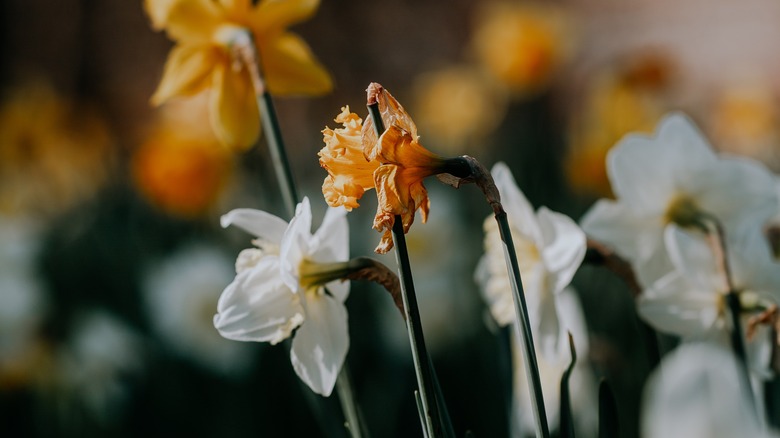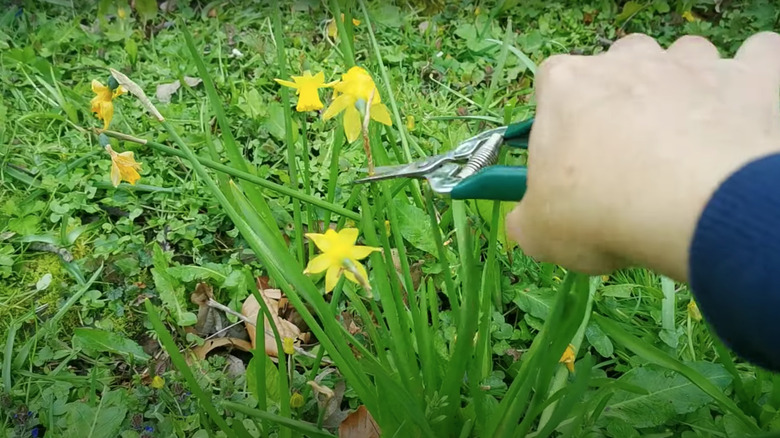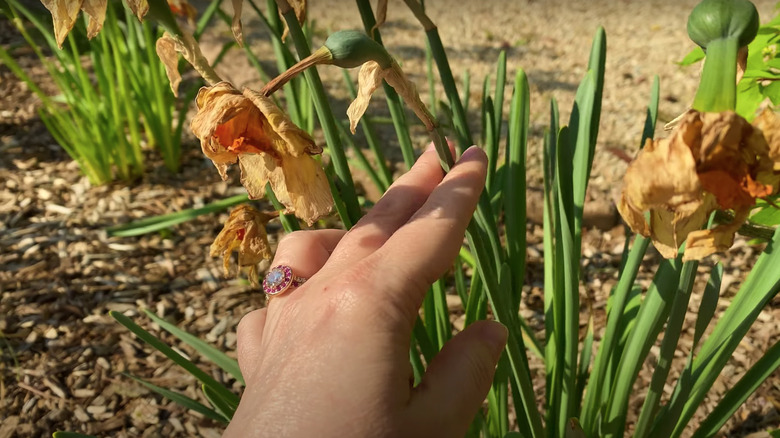
Ben Collins/Unsplash
Behold the grand spectacle of daffodils in full bloom, signaling the arrival of spring while adding a splash of color to your garden. But even the most beautiful symphonies must reach their finale, and so must daffodils’ dazzling display. Enter the art of deadheading. It’s as simple as grabbing a pair of sharp scissors or pruners and sniping off the spent flower head. Timing, however, is of the essence here. Aim to deadhead the plants post-bloom, ideally before the seedpods develop further. And while the prospect of tidying up those green leaves may seem thrilling, please let Mother Nature run her course. The leaves should wither away in due time, but exactly when depends on the weather and bulb variety.
But what happens if you don’t deadhead daffodils? As for this, let’s weigh the merits of snipping those wilted flowerheads. The primary goal is to foster bulb vigor. Deadheading prevents the wastage of precious energy on seed production, ensuring your daffodils burst back onto the scene with an added vengeance. Consider also that wind can disperse seeds, sparking a veritable buffet of spontaneous daffodil uprisings. And we mustn’t overlook the aesthetic angle. A garden teeming with vibrant, blooming daffodils is a sight to behold. But one littered with faded, brown, and dying flowers? Not quite the same allure. After all, you wouldn’t want your garden to resemble a post-apocalyptic wasteland.
How to deadhead daffodils

YouTube
“What is the best way to deadhead daffodils,” you might wonder. You must decide whether you’re a hands-on warrior or a pruner-wielding knight. If using your fingers, wear clean gardening gloves to prevent infection transfer. Gently grasp the dead flower at the top section of the stalk and give it a twist and a pull. Should you choose the path of the small hand pruners, sanitize them with a diluted bleach solution before you begin your quest, and if possible, between plants. Simply snip the dead flower off just above the top section of the stalk.
(We may receive a commission on purchases made from links)
Now, a word of caution: don’t twist or bundle the leaves. Instead, let them hang freely and bask in the sun’s glorious rays. In the same line comes the temptation to snip off the foliage. Don’t! Those leaves are the daffodils’ energy factories, converting sunlight into food for the plant. So, let the foliage wither away naturally, which takes 4 to 6 weeks after blooming, depending on weather and bulb type. Snipping is only one step to ensuring your daffodils return year after year with renewed vigor. Another secret ingredient is granular fertilizer applied 1 to 1.5 pounds per 100 square feet. However, beware of fresh manure or high-nitrogen fertilizers, as they can cause excessive leaf growth (at the expense of flowers) or even damage the bulbs. Watering is crucial, but don’t flood your garden (nor hydrate during the dormancy stage) to prevent bulb rot.
When to deadhead daffodils plus additional tips

YouTube
The optimal time to deadhead daffodils is after the flowers have faded and withered. It’s when the plant’s energy begins shifting from flower to seed production, and you want to nip that process in the bud (pun intended). Removing the spent blooms allows the plant to focus on what truly matters: strengthening the bulb for the next blooming season. As for the post-trim timing, let the leaves grow and die back naturally. Of course, you don’t anticipate the dreaded “daffodil leaves, but no flowers” situation. But suppose fate strikes, will blind daffodils flower again? Indeed, but as long as you fix whatever is limiting blooming.
As you shower your daffodils with affection, be vigilant against unwelcome guests. Any bulbs affected by narcissus flies or nematodes should be discarded — it’s tough love, but it’s for the greater good. A good spray pesticide should send bulb mites packing, but a foliar fungicide will suffice for fungal foes like smoulder, neck rot, leaf scorch, and basal rot. And if you’re new to the game? Look out for additional daffodil planting tips. Best of luck as you unleash your inner gardener to ensure your outdoor space remains a beacon of joy and inspiration.



